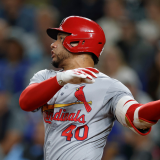
Why you should blame Jeff Loria, not Derek Jeter, for Giancarlo Stanton trade
The Marlins are in bad shape right now, and that's on the previous owner
The motivation for the Marlins' trading of reigning NL MVP Giancarlo Stanton was a simple matter of money. They wanted to offload as much of the $295 million left on Stanton's contract as possible, and that necessarily meant an unimpressive collection of talent coming back. That's how these trades work. Compounding matters was Stanton's full no-trade clause, which limited the number of possible destinations and hence the Marlins' leverage in talks.
So a mediocre team has sloughed off its generational player in exchange for nothing but improved financials, which isn't exactly inspiring to anyone who's not a bean-counter.
If you're a Marlins fan -- either of them -- then you're probably surveying the horizon for someone to blame for all this. Freshly minted CEO (and Yankee legend) Derek Jeter is an obvious target, and it's of course possible that Jeter's regime mishandled this entire affair. The real blame for the club's current straits, though, falls on former owner Jeffrey Loria.
It's not exactly breaking news to declare that Loria was a terrible owner, but it's worth examining his more recent failures and how they put the Marlins in this position. Consider ...
It was Loria who signed Stanton to that contract
The Loria regime in November of 2014 inked Stanton to that 13-year, $325 million contract. While the full no-trade clause has been the source of much hand-wringing, that's standard stuff for a contract of any sizable scale (and I'd argue it's very much a good thing for players to have some control over whether the team they commit to can ship them off). What's notable is the back-loaded nature of Stanton's deal. He's now three seasons in, and he's been paid just $30 million. Stated another way, Stanton's played out more than 23 percent of his contract but earned less than 10 percent of the total monetary value. In raw terms, he's still owed $295 million, assuming he doesn't opt out after the 2020 season.
Speaking of which, that opt-out probably won't be invoked thanks to that lucrative back end. At that point, Stanton will be going into his age-31 season and still be owed more than $200 million. If he stays generally healthy and productive, then it's possible he'll be able to best that figure on the open market, but it'll be a risk.
The larger point is that Loria, by signing Stanton to a contract that's so long but pays him so little in the early years, created a problem for someone else. I have no doubt that in November of 2014 Loria knew he wouldn't be the Marlins owner when Stanton's tab really came due. Of course, the Stanton obligations were baked into negotiations when Loria sold the team, but the reality is that the structure of the deal meant that Loria wouldn't have to make the tough decisions.
We tend to frame player contracts as being good or bad for owners, and that's a one-sided approach. This is a very good contract for Stanton, and that's worth remembering right now.
It was Loria who failed to create adequate revenue sources
Stanton's contract wouldn't be a problem for almost any other team. Thanks in part to escalating media-rights deals and the cash influx from the sale of BAMTech to Disney, MLB is rolling in money right now. Heck, it's a $10 billion business for the first time. That tide lifts all boats, but the Marlins under Loria didn't do their part to create their own revenue streams.
First and foremost, Loria -- because he wanted taxpayers to pay for his place of business -- agreed to put his ballpark in a part of Miami that's inconvenient to fans and, by extension, to all means of transportation. Getting into and out of Marlins home games is an ordeal of substantial proportions. Even the ride-sharing lot is an ill-defined thing that's almost a mile walk from the ballpark. There's also nothing else in the area to attract fans.
Loria could've built his stadium in a more accessible part of Miami, an area people actually wanted to go to, but because that might require him to, you know, pay his own tab, that didn't happen. It was a woefully short-sighted decision, and now the Marlins are locked in. In matters related, just the A's and Rays drew fewer fans last season.
As well, the Marlins have probably the worst local-media rights deal in all of baseball, and they still don't have a ballpark naming-rights agreement.
In matters related, the Marlins under Loria simply weren't able to cultivate any baseball enthusiasm in Miami. Sure, that's not all on them, but consider the red carpet parade at this year's All-Star Game in Miami. Here's Giancarlo Stanton working the route to the cheers and adoration of, oh, four or five people ...
Our hometown hero! Good luck tonight @Giancarlo818 ⚾️#ASGRedCarpet pic.twitter.com/MRWDZR9cjk
— Miami PD (@MiamiPD) July 11, 2017
I don't believe that the Marlins are losing money. It's nigh impossible for a modern MLB franchise to lose money absent accounting trickery (they're not required to disclose financials publicly), and we know for a fact that the Marlins were wildly profitable during the same time they were crying poor in order to extort a new ballpark from taxpayers. That said, Loria and his hapless lieutenant David Samson put the franchise in a bad spot relative to pretty much every other competitor. All of that plausibly left the new owners with an urgency to address the ballooning Stanton contract.
So blame the Jeter regime for maybe not getting the best deal for Stanton, but blame Loria -- now roughly $1 billion richer for his mismanagement -- for putting the Marlins in a position that led them to pawn off their signature talent.
Jeter and money man Bruce Sherman may yet prove to be terrible owners, but we know Loria was a terrible owner. That Stanton is no longer a Marlin is the legacy of Loria's incompetence, willful or otherwise.


















